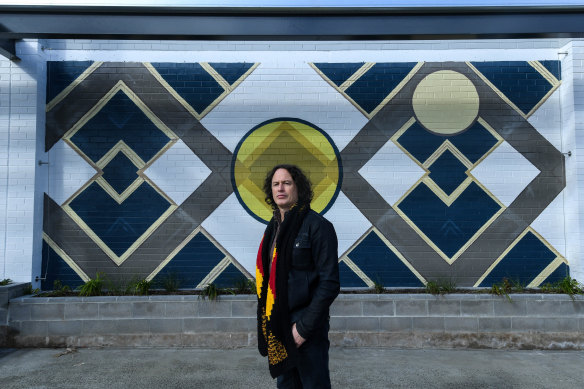Through The Torch, art becomes a lifeline, a way to process trauma, express emotions and envision a better future, he says. Prisoners, some of whom know little or nothing about their culture, are empowered by connecting and learning about it. Their artwork is sold through the organisation, which has a shop in Carlton, an online store and holds annual exhibitions, and 100 per cent of the sale price goes directly to the artist.
The Victorian Aboriginal Art Policy allows artists to earn income from their artwork while incarcerated. The Torch also provides support programs to prisoners after their release, which helps socially and economically.

Kent Morris in front of his mural called Ancestral Connections – The Ties That Bind in Brunswick. Credit: Justin McManus
Many prisoners have been disconnected from their culture as part of colonisation, Morris says, and often find themselves at a loss. Through The Torch, they can find those connections and “feel that sense of pride and like you belong in the world”.
“The support can’t stop at the prison gate, it has to continue on in the outside world. Without work or money, you’re incredibly vulnerable,” he says.
Artists’ work can also be licensed through the program, which is funded by the Victorian Department of Justice through Corrections Victoria, providing an additional income stream.
Blak In-Justice deliberately includes both well-known and emerging artists, those who have been in jail and those who haven’t.
“Artists commenting on this extraordinary issue that is such a great stain on the nation, it crosses all generations, all genders,” Morris says. “These voices have never been brought together in the one place at the one time.”
Criminalising Babies (2025) by Karla Dickens.Credit:
A powerful new work by Karla Dickens, Criminalising Babies (2025), features two children, aged eight and 10, wearing balaclavas. The minimum age for criminal responsibility across Australia is 10.
“Putting babies of that age in prison is just dumbfounding to me,” Dickens says.
“I spent time in Redfern and I would go out when the police were around harassing kids; they were provocative.
“Of course, not all kids are well behaved, but the way that they’re handled, the way that they’re treated, doesn’t promote good behaviour, or self-worth or being valued in a society – because sadly First Nations people in this country aren’t. I just find it horrifically right-wing and racist.
“People end up in jail, then their children suffer, their parents suffer, everyone in that family suffers.”
In recent years, NSW police have operated under an Aboriginal Strategic Direction policy document. Speaking in 2024 in response to concerns of racism within the force, Commissioner Karen Webb said police had committed significant resources towards Closing the Gap, including mandatory cultural awareness training for officers.
Now working two days a week as gallery manager for The Torch, Edwards continues to paint using her signature diamonds, as well as making more experimental works. She has five months left on parole.
“Learning culture is still a journey for me,” she says. “The Torch program has been life-changing. I don’t know what I would have done with my criminal past, being in prison for such a long time. All that has been essential because The Torch has been there for me.”
Blak In-Justice: Incarceration and Resilience runs from April 5 to July 20.

